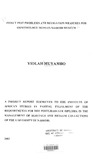| dc.description.abstract | This study investigated insect pest problems affecting ornithology specimens in the
ornithology storeroom of Nairobi Museum of the National Museums of Kenya It also
investigated the mitigation measures used by the ornithology staff to deal with these
problems. Insect pest problems are a result of insect pests gaining access to the storeroom and
to the collections and obtaining harbourage where they can live and breed. Insects require
moisture, food, warmth and harbourage for survival.
A survey form was used to collect information about the history of the building, prior pest
infestations and mitigation measures against insect pest infes~tions..:A facility and collection
- - .:
survey was carried out to find out the insect pest problems and the mitigation measures in the
ornithology storeroom. Insect traps were used to trap insect pests in the storeroom as part of
the survey. The temperature and humidity of the storage area were recorded using a
thermometer and hygrometer, respectively. Individual ornithology skins we~ examined to
investigate signs of infestation. Finally, key informant interviews were conducted to get
information about pest control management in the' Ornithology Department.
Mitigation measures are practised to counteract insect pest problems by denying the insect
pests access to the store and the collections, and also denying them a conducive habitat and
food sources. Qualitative data obtained in this research was analyzed using the non- . J
computerized method of content analysis. This analysis revealed the methods of pest control
employed by the staff and the mitigation measures offered by the storage facilities. Numerical
data was obtained for the environmental factors studied in this research and mathematical
analysis was used to obtain the maximum and minimum temperature and humidity readings
for one fortnight.
The main finding of this research was that the use of naphthalene is the major mitigation
measure, and this has enabled the department to counteract insect pest problems. The
concentration of naphthalene is so high that no insect can survive in the ornithology
storeroom. However, the literature reveals that the use of naphthalene results in health
problems to staff and have long-term negative effects on the ornithology skins.
On the basis of these findings it is recommended that research should be done to determine
the effective levels of applying naphthalene with<;>utendangering the shelf-life of the
ornithology skins and the health of staff. F~~r research needs to be.done in order to apply
non chemical methods of pest control and use the Integrated Pest Management (IPM)
approach.
J | en |

